Magicshine MJ-808 P7 10W LED lamp (for MTB use)
This lamp was lent to me by Jack van Messel in June 2010. Thanks!
Specifications:
Mass: I forgot to weigh it during the time I had it on loan (apparently: ca. 112 g for the lamp head and ca. 200g for the battery).
Size: ∅ ca. 43 mm, ca. 50 mm long
LEDs: Seoul P7 LED, cool white
Price: ca. $80,- + VAT + import duty.
Pictures:
Mounted on a bicycle it looks like this:
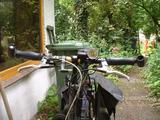
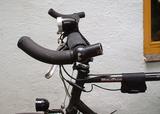
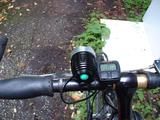
The lamp head is mounted on the handlebar with a thick rubber band. This seems to be good enough so the lamp doesn't shift when going over bumps etc., but when you press the button (to switch between high, low, strobe, off), you need to keep hold of the lamp head as well to prevent it rotating around the handlebar.
|
Introduction
This section is a comparison between an Edelux (180 lumen at 30km/h) and a P7 LED lamp called 'Magicshine' that's being sold direct from China, but also by various distributors in many countries. The aim is to see what more light brings, how a circular beam compares to a beam with cutoff in both what you see with it, and what you see when you encounter someone with such a lamp, etc.
The Magicshine has a Seoul P7 LED driven at about 10 Watt, comes with a Li-Ion battery and charger. The lamp has a circular beam (no cutoff) and is mainly meant for mountain biking in the evenings (in winter mainly, when it gets dark early). The cost is ridiculously low for such a lamp, about €65 (+ tax + import duty). Although it's advertised as a 900 lumen lamp, it's been measured at about 550 lumen (maximum, when it's cold, note that LED lamps give less light the hotter they get), see: http://www.mtb-news.de/forum: Die Stunde der Wahrheit, page 14.. There you can also see it gives the same amount of light as a Lupine Tesla while using only 2/3 of the power.
It has 3 light settings: High, low, strobe (useless! except to blind people...)
Pressing the button switches on in high, after that the button cycles through the modes and off. Keeping the button pressed for 2 seconds switches the lamp off directly.
Impressions while riding
The comparison between Edelux and Magicshine was done on the same bicycle. To compare lighting patterns and what aiming the Magicshine further or closer changed and how it compared to the Edelux in each position, I switched between having the Edelux and Magicshine on many times, giving a good impression of how good/bad the Magicshine's beam pattern is compared to the Edelux, wherever it was aimed (near, far, or in between).
Note: The night shots are all fairly dark. The pictures of beamshots and oncoming views look much darker than what I experience with these lamps, which is due to my camera's probably not very sensitive CCD and/or the short (automatic) exposure time. It's no problem though, to see beam shapes and be able to compare oncoming shots of the Magicshine and Edelux.
- The beam shape gives a bright bit just after the wheel, then it gets a bit darker, and then we get to the hotspot. This hotspot and the side spill give the impression of a very bright light, but it's not that simple and I will examine this more in the following analysis. Here are some pictures of the light beam:
[ Lamp height: ca. 1.05 m, Camera height: ca. 1.15 m, Old Fuji 2600z, automatic (it has no shutter time/diafragm/ISO settings), 2M pixel ] (When/if I get hold of a Magicshine again, I will make beamshots with the ST70 camera):
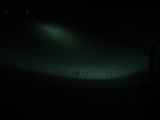
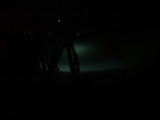
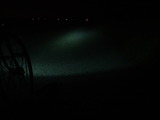
(In the background you see dots from street lamps from another street far away)
- The low beam gives perhaps the same amount of light (in the brightest spot) as an Edelux does (but the Edelux does is over a large area) when aimed not too far away, but all in all it's less useful. When aiming the hotspot not too far to give a good illumination of the road surface, the lamp doesn't have the throw of an Edelux, i.e. certainly not a good illumination of the road surface up to about 40-50 metre because the part of the beam that gets there is too weak. Aim the hotspot further to properly light up the road 40 metre ahead of the bicycle, and the light that gets on the road is fairly weak nearer the bicycle (weaker than with an Edelux) and still the road is not as well lit up at long distances (ca. 40 m) as an Edelux.
- The high beam gives the impression of a lot more light than an Edelux, but as I wrote elsewhere, about 0.6 to 0.7 of the beam gets onto the road. This means about 330 to 385 lumen get onto the road, around twice as much as an Edelux. But it looks much brighter because of the brightly lit up area just ahead of the front wheel, and the hotspot. If I aim the hotspot far away so that I get good light on the road up to about 40 metre, then the area on the road is lit up about as well as with an Edelux, it's just that the Magicshine's beam is broader, and more uneven (bright bit, then darker, then the hotspot). The broad beam that also illuminates upwards (trees on the side of the road for example) gives you more the impression of riding in daylight...
- Oncoming traffic encountering a bike with the Magicshine sees this:
[ Lamp height: ca. 1.05 m, Camera height: ca. 1.70 m (taken without tripod, a little below eye height), Old Fuji 2600z, automatic (it has no shutter time/diafragm/ISO settings), 2M pixel ] (When/if I get hold of a Magicshine again, I will make shots with the ST70 camera):
At 50 m:
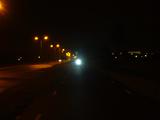
At 5 m:
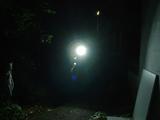
Interestingly, it doesn't matter much whether the beam is on high or low, they both give almost the same impression (i.e. there is little difference in light intensity seen by the eye looking into the beam, and camera shots give the same result), and that is of a 'very bright light coming at you'! This means setting the lamp on low to make it less annoying to oncoming traffic is pointless. Well, almost pointless, there is a small difference in how long oncoming riders are blinded on unlit roads, as you can read below.
Some more investigations: I checked out what I would see with an Edelux when encountering a rider with a Magicshine P7 lamp, one lost night on a lonely country road, looking for a shortcut that I never found. Oh no, that was something else :). Well, it was on a country road, no street lamps at all. I put the lamp on a pole, about the same height as the lamp would be when mounted on the handlebar of a bike (and it was aimed fairly far). I then rode towards this lamp with my bicycle with Edelux headlamp, to see in particular how annoying the P7 lamp would be.
Here are images of the Magicshine at 220 metre, 140 m, 80 m and 30 m:
[ Lamp height: ca. 1.05 m, Camera height: ca. 1.70 m (taken without tripod, a little below eye height), Old Fuji 2600z, automatic (it has no shutter time/diafragm/ISO settings), 2M pixel ]:
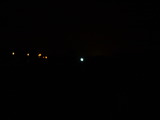
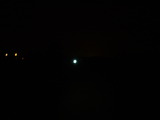
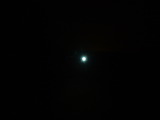
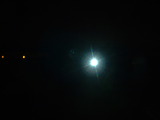
(the yellowish dots are street lamps of a road somewhat further)
Here's a shot of the Edelux at about 20 m:
[ Lamp height: ca. 0,70 m, Camera height: ca. 1.15 m, Old Fuji 2600z, automatic (it has no shutter time/diafragm/ISO settings), 2M pixel ]:
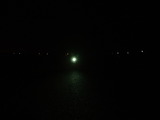
It's obviously far less bright than the P7 at the camera position, as it should be as it was aimed below the horizon (i.e. cutoff below the horizon), so most of the light gets onto the road surface. Note also that the Edelux has a more greenish tint...
The annoyance from the P7 lamp isn't that bad as compared to some much dimmer bike lamps, where it isn't caused by the amount of light but by 'artefacts' in the light/reflector. But it was problematic in another respect:
- Low beam: When I got to about 23 metre of the lamp I could not see the road, not anything beside it (berm, shoulder), or anything at all in fact but the light from the lamp. And this despite the fact that I was using the Edelux on my bike. So the brightest dynamo powered bike lamp with cutoff, is useless to see the road when encountering someone with this P7 powered lamp. A wider road would not have helped much, it would have to be much wider than any regular road.
- High beam: When I got to about 32 metre of the lamp, I couldn't see anything but the light from the lamp.
It was in fact worse than riding at night on a road mainly for bicycles that is parallel to a road where cars drive. In one of the directions you will be extremely annoyed by car headlamps, which often don't have a proper cutoff to the sides. The result of this poor cutoff to the sides of car headlamps, is that it's more annoying to ride on this road beside the main road, than if you were to ride on the main road and the car's light would come almost directly at you. See the Annoyances from lamps page for more information.
Someone I showed the P7 lamp to a while back at night, said the lamp "should be forbidden" and I agree (note that it is in fact illegal to use this lamp on public roads in Germany (No StVZO approval, obviously) and the Netherlands (because it blinds oncoming traffic). Even on low it will make cyclists coming in the opposite direction armed with an Edelux unable to see the road on unlit roads (nor anything on the sides, so they won't know when they get to the edge of the road) for a long distance which is dangerous, and on lit roads or in the city you don't need this lamp.
Note that this test of the P7 lamp at night was the worst case scenario: Completely unlit road, and the rider with the P7 lamp had it aimed quite far, so you get a very high intensity light shining in your face.
I later tested inside a city on a street with plenty of street lamps, with the P7 aimed not very far away. The light was very bright but didn't blind me. Aiming the lamp further was very annoying and though I wasn't blinded as there was plenty of light on the street, it was getting very close to being blinded.
Update 3 December 2010: I already noted this with my review of the Lupine Betty 2011, but will place it here as well: The oncoming test with the Lupine Betty made it clear it's not the amount of light per se that blinds you, but having a fairly strong hotspot. A strong light in your face such as the Lupine Betty is very unpleasant, but won't blind you completely because the beam is much more homogeneous, so you can still see the road from the light that the Betty puts out. This doesn't work for the Magicshine, as its hotspot is fairly strong, and its main beam is weak except very close to the bike.
Conclusion
The Magicshine is amazing for the price, and shows what more light can do. It gives more comfort and it is nice to have more light on the road than the Edelux gives (which is the case for a short distance from the front wheel) as I've experienced when comparing it to the Edelux. However, the circular beam is annoying to oncoming traffic, and even dangerous in some cases as you get totally blinded for a fair distance, and whether set on high beam or low beam makes almost no difference to that. Further, the beam doesn't give a smooth light carpet that the Edelux gives, which means it's actually not any better than the Edelux (for riding on the road). So it shows that more light on the road is very nice but also that a beam with cutoff is necessary for not annoying oncoming traffic, safety, and using the available light efficiently.
One final point: An Edelux that's aimed incorrectly (with the cutoff above the horizon) is even worse than the Magicshine for oncoming traffic. More about this can be found on the page about annoyances caused by lamps.
Last modified: Fri Dec 21 10:49:21 CET 2012












